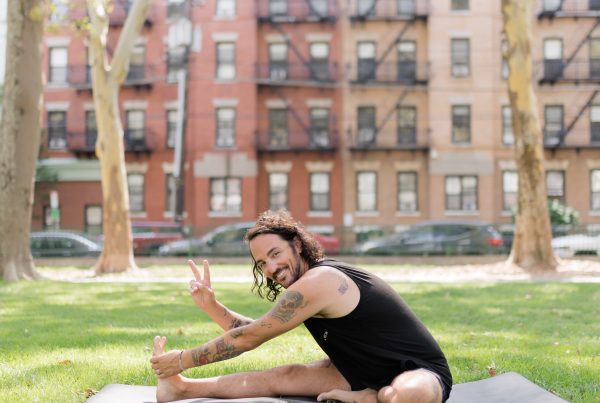
Ayurveda is a 5,000 year old science that is often referred to as the science of life and also the sister science to yoga. It can be understood as the study of all of the qualities you see around you and how they interact with you.
Ayurveda teaches that you are born with a specific and beautiful blueprint that’s unique to you. Therefore the food, drinks, and activities that bring you to balance may create an imbalance for someone else. You need to notice your own personal rhythms, tendencies, and what brings you bliss.
Everything on earth, including you and everyone around you, is made up of the elements fire, water, earth, air, and ether (or space). These elements come together to create the three doshas. Pitta dosha is made of fire and water. Vata dosha is made of air and ether. Kapha dosha is made of earth and water. The doshas oversee many things in this world, including the seasons!
Ayurveda and The Holidays
The holiday season can range from stressful to exciting and from fulfilling to depleting. Depending on what you are currently experiencing in your mind, body, and heart, the doshas will show up in various ways. Let’s take a look at each of the doshas and how you can find and maintain balance this holiday season.
Understanding Vata’s Mobility
Late fall and winter, which make up most of the holiday period in some parts of the world, is typically aligned with vata season. This season is characterized by qualities of cold, light, dryness, mobility, and subtlety. Vata, made up of air and ether, governs movement and change in your body and mind. A vata imbalance can manifest as restlessness, anxiety, and physical dryness, which during the holidays, might translate into feelings of overwhelm, erratic schedules, and dietary irregularities.
Tips for Balancing Vata:
- Favor warm, moist, and hearty meals during this time as they can provide the much-needed grounding energy. Think of nurturing soups, stews, and warm beverages. These foods counteract the cold and dry nature of vata, bringing comfort and stability during the holiday hustle.
- Establish a routine. Regularity is key to balancing vata. Maintaining a consistent schedule for sleeping, eating, and self-care can greatly mitigate vata’s erratic nature, which often gets amplified during the holiday season’s irregularities. Try to wake up, go to bed, and have meals at the same time each day. Even if you can only do one of those things at the same time, it will be incredibly beneficial.
- Embrace mindful practices: Integrating calming activities like meditation, grounding yoga, or pranayama, particularly during vata times (2pm-6pm and 2am-6am), is helpful. These practices offer a sense of calm, centering the mind and body, and countering the scattered energy characteristic of imbalanced vata.
Pitta’s Fire of Passion
While vata may dominate the holiday season, the holidays also have a way of igniting the fiery element of pitta, which is the dosha of transformation and is composed of fire and water. This can manifest as a passionate drive to create the perfect holiday experience, potentially leading to stress and burnout. You may also see pitta manifest as family or work drama, extreme emotions, and heated arguments.
Tips for Balancing Pitta:
- Cool it down and try to relax! It’s important to take time during holiday preparations to relax and to literally cool down. Engage in activities that soothe the soul, like leisurely nature walks, listening to calming music, or enjoying quiet moments of reflection. Diffuse essential oils like rose or lavender and favor movies that soothe the heart (try to avoid those action movies!)
- Eat mindfully. The holiday season often brings with it a temptation for spicy and hot foods that can aggravate pitta. Opting for cooling and nourishing alternatives can help balance Pitta’s intensity. Focus on consuming foods that are sweet, bitter, and astringent.
- Practice patience and compassion towards yourself and towards others. The holiday rush can test your patience. It’s a time to cultivate compassion and patience, both towards oneself and others. Remember, the essence of the holidays is not perfection, but connection and joy. Write out gratitude lists, take the time to tell loved ones how you feel, and remember to savor the sweet moments as they come.
Kapha’s Stability
Kapha, constituted of earth and water, brings qualities of stability, nourishment, and care, which are essential during the holiday season. However, excessive indulgence in heavy foods and a sedentary lifestyle can disrupt Kapha balance.
Tips for Balancing Kapha:
- Stay active! Regular physical activity, which counteracts kapha’s tendency towards sluggishness, is crucial. This could be as simple as a brisk walk, a fun dance session, or any form of exercise that invigorates the body. According to Ayurveda, taking at least 100 steps after each meal can help stoke the digestive fire and move stagnant energy. 100 steps isn’t a lot! Try to get in the habit of cleaning up your dishes after you eat or tidying up something at home or at work.
- Choose foods that don’t weigh you down. The holidays can bring food choices that are heavy and rich. Remember, most things are okay in moderation, but if you’re already feeling heavy, avoid foods with those same qualities. Incorporate spices like ginger and Remember, being more mindful of portion sizes and avoiding overeating are key during the holiday feasts.
- Cultivate joy and connection! Kapha thrives on love, connection, and emotional stability. Engaging in activities that foster these, like spending quality time with loved ones or participating in community events, can nourish kapha. If you aren’t able to spend physical time, try writing letters or making phone calls to the people you love and miss. Connection is key!
Some of the most simple practices in Ayurveda can be the most transformational. You don’t have to completely change your entire lifestyle to experience benefits. Many of the practices are about happiness and fulfillment and enjoying the time you have here during this lifetime. They connect us to the elements around us and provide us with the tools we need to experience them in a loving and blissful way.
When you understand nature, your body, and your rhythms, you can embrace what’s happening and celebrate everything your beautiful body is capable of and all that it does for you. So much of this practice is about paying attention and diving deeper into what makes you smile and what makes you excited to move through this life.
Ayurveda teaches us to do all things with love. When you can embody this concept, you can find ways to come back to balance and inspire others to do the same. The holiday season, with its delightful yet chaotic nature, presents an ideal opportunity to practice Ayurvedic principles for maintaining balance and wellness. By understanding and nurturing the doshas (Vata, Pitta, and Kapha) you can approach this festive period with mindfulness, joy, and deep nourishment.
These Ayurvedic tips are not just practices but a lifestyle approach, guiding you through the holidays with health, harmony, and a heart brimming with festive cheer. I used to think Ayurveda was similar to a fad diet or program, but it’s actually the complete opposite. It’s a lifestyle that leads us back to the realization that we are loving beings meant to connect to love within ourselves and this beautiful world around us.










